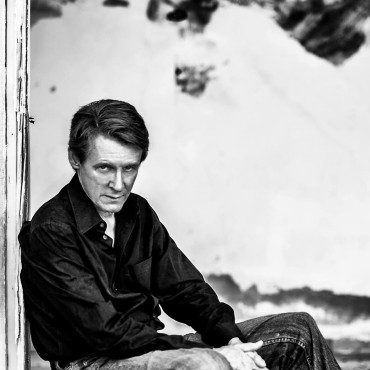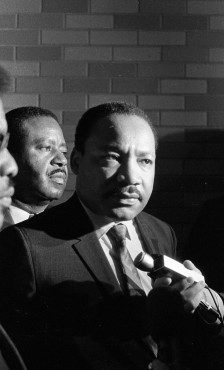
Record producer and photographer Terry Manning had “A Conversation” with “Jake’s Take” before the premiere of his Boston Cyberarts Gallery exhibit. (Photo property of Simon Mott)
By: Jacob Elyachar, jakes-take.com
For Terry Manning, he has built a career out of two loves: music and photography.
When he first entered the music industry in the late 1960s, Terry worked as an engineer and producer at the iconic Stax Records and Ardent Studios, where he worked with a diverse group of legendary acts that included Ike and Tina Turner, the Staple Singers, the Reverend Al Green, Otis Redding, Leon Russell and countless other musicians.
As he continued his journey in the music industry, Terry also showcased his gifted photography skills by taking intimate photos of Chuck Berry, Dusty Springfield, Janis Joplin and Jimi Hendrix as a writer and photographer for New Musical Express.
Today, Terry will premiere several of his iconic photos at the Boston Cyberarts Gallery at Jamaica Plain, Massachusetts for a 10-day exhibit.
In this edition of A Conversation, Terry opened up about his favorite photo subjects and how working with music legends helped him grew as a musician and producer.
Jacob Elyachar: When did you get interested in photography?
Terry Manning: I have been interested in photography almost as long as I have been interested in music. During the early days of my career (the early 1960s to early 1970s), I worked with a lot of musicians and did photography as well. Both music and photography captured both my imagination and soul. While I made money on both art forms, I received more inquiries and projects from music. Over the last few years, I was bothered by the fact that I was not doing everything that I set out and wanted to do. A couple of people encouraged me to get my photos out, so that the public could see them.
JE: Let’s talk about the opening of your exhibit at the Boston Cyberarts Gallery. How long did it take you to decide that you wanted to display your photographs?
TM: It all started when I met a guy named Chris, who ran MIT’s photography department. He kept inquiring about some of my photos. He was very interested in seeing my photo of Dr. Martin Luther King, Jr. and said to me: “Why don’t we present these photos to the public?” I was interested in it, but then a new music project came up and the photo display kept getting put on the backburner. After a couple of years, he stated: “Look, you should do this! Don’t neglect this opportunity!” It took three-and-a-half to four years to force myself to overcome several personal obstacles to have an epiphany in the form of Nike’s “Just Do It.” A year ago, I began to retrieve countless boxes of negatives that ranged from the beginning of my career to the present day.
JE: Who were your favorite photo subjects? What made them stood out?
TM: Every time I had the opportunity to take photographs, I look for something that captures my eye. It could be one silly little object that captured my attention while I was traveling. While everyone else is walking past it, the little object spoke to my creativity and I capture that object on film. However, I do not take the picture unless there is a reason to capture the object on film. Sometimes, you should not overlook everything in life. You need to stop and assess things instead of running back and forth.

Terry Manning was very fortunate to have taken the last photo of Dr. Martin Luther King, Jr. before his tragic assassination. (Photo property of Terry Manning; courtesy of Effective Immediately PR)
Of the photos I have taken over my career, I am extremely fortunate and grateful to be around incredible people such as Lenny Kravitz, Marvin Gaye, Dusty Springfield and Chuck Berry. However, my very favorite person I was around has to be Dr. Martin Luther King, Jr. He is in his own class far different from any star or well-known people. In fact, the photos I took of him were hours before he was tragically killed. That photo is very, very special to me. I was very fortunate to meet a lot of great, talented and nice people that mean a lot to me. I was extremely lucky enough to photograph my subjects through a photojournalism approach.
JE: I want to jump and talk to you about your career in the music industry. You have worked with a diverse group of artists such as the Reverend Al Green, Otis Redding, the Staple Sisters, Janis Joplin and Jimi Hendrix. What lessons did you learn from them that helped you grow as a musician?
TM: One of the most important things that I learned from these artists was that you had to have both the talent and credentials to be a big star. A lot of the celebrities that are in today’s industry are stars because they are famous for being famous. Throughout my career, I was around people who had an inner drive…that is very specific thing that most people do not have! Lenny Kravitz, Shakira and Jimmy Page really have the talent and a deep inner drive, which will never allow them to quit or lose. There is something about that spirit and when I see that or I am around that, I am left in awe. That spirit makes you want to be like them or have the same spirit and drive that they do!
JE: In your humble opinion, how has the music industry evolved? Has it evolved for the better? Has it evolved for the worse? Why?
TM: There are two areas we could examine. In one area, you have quality of music and depth of talent. In another corner, there is the whole music business itself and how it is operated. If we are talking about the business itself and how it operates, it has changed drastically over time! From the early 1960s to early 1980s, the major record labels were machines. They bankrolled the recordings and were marketing empires that found people and transformed them into artists. The labels also had A&R (Artist & Repertoire), who were experts in talent seeking and paired their talent with the best producers, engineers and managers. It was really a major enterprise. Today’s music industry is not really like that…. it is more segmented and artists have to do the marketing (and provide the bankroll) themselves! Yes, the labels will sign people…but not like they used to. They will not put the right combinations of artists, managers, producers and talent scouts together. I am not putting down the remaining big labels, but it is a different marketplace.
To get back to the quality of music and depth of talent portion, the Internet has given the people the power to record music in their own bedrooms. From creating the music to building your cover art on your lab top, you can do everything in your own room. After you do all that work, you can just submit it online and by tomorrow morning, people in Spain, South Africa or Israel could possibly hear it. However, what I do not like about the Internet is that it is harder for artists to get their voices heard above the thousands that are submitting their music through their bedrooms, garages and studios. Everybody is trying to be a star and now they have to yell above the millions who are trying to do the same thing.
JE: If you had the chance to meet with musicians or producers who want to work in the music industry, what advice would you share with them?
TM: If someone wanted to get into the music business as an engineer, producer or studio owner-operator, I would recommend that person go to a real university such as the University of Indiana or University of Memphis that have accredited music programs that specialize in the various technical art forms. As for people who want to enter the arts itself, I think it is great to get a music education and learn more about theory and the typical aspects of music…. but that is not going to make you a rock star. No matter what you learn through these arts forms, you are going to have to get out there and get real world experience! You are going to fail and not be afraid to look silly! If you cannot do that, then you cannot be a front man or a star.
Want to see some of Terry’s photos? Head to his website.
To learn more information about the exhibit, visit the Boston Cyberarts Gallery website!
You can let Terry know that you will be attending his exhibit by RSVPing on the exhibit’s Facebook page.




